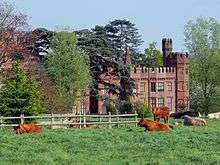Faulkbourne Hall

Faulkbourne Hall is a manor house in the village of Faulkbourne in Essex. It is the centre of the Manor of Faulkbourne, first recorded under Edward the Confessor. Its grounds contain the village church of St Germanus.
The earliest surviving parts of Faulkbourne Hall, a red-bricked building with turrets, date from the 15th century. The Hall range was aligned NE-SW with a cross-wing at NE end in 1439-1449. A range was added to the NW in 1449-1494 together with a square tower at the N corner and a stair turret at its E corner. Sir Edward Bullock had purchased the Hall and the Manor of Faulkbourne in 1637 and made substantial additions to the building. A further wing to SE of the crosswing was added in c. 1693. Further extension was made in the 19th century in the S angle. The Hall is a fine specimen of Early Tudor red brick, listed Grade I.[1] The exterior of the house holds a number of metalled vanes in the form of flags bearing the initials of the Bullock family. The Bullock family continued to live there until the turn of the 20th century. Richard Henry Watson Bullock C.B. (1920-1998)[2], who was Deputy Permanent Secretary at the Department of Trade and Industry, is recorded in Who Was Who as being a consultant for Faulkbourn Consultancy Services.[3]
See also
References
- ↑ "British Listed Buildings".
- ↑ "London Gazette, 12th June 1971, p. 5959" (PDF).
- ↑ "Who Was Who". St. Martin's Press, 1996. p. 76. Retrieved 30 August 2018.
Consultant, Faulkbourn Consultancy Services....of late Sir Christopher Bullock, KCB, CBE and Lady Bullock (née Barbara May Lupton);